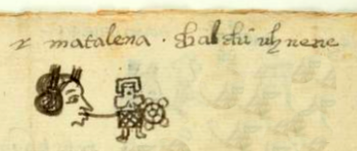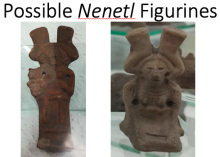Chalchiuhnene (MH559v)
Chalchiuhnene (MH559v)
This black-line drawing of the compound glyph for the personal name Chalchiuhnene (“Precious Female Genitals,” a translation suggested by Gordon Whittaker, April 2023) is attested here as a woman’s name. The precious green stone (chalchihuitl), in a frontal view, appears to the right of the doll (nenetl), also in a frontal view. The doll has a helmet-like hairstyle and a mesh-patterned skirt. Both of these logograms (the doll and the green stone) can refer to women's genitals, according to Whittaker. Chalchiuhnenetl was a name held by at least two famous women, wives of male Nahua leaders. See our Online Nahuatl Dictionary.
Stephanie Wood
This glyph stands out among all the nenetl glyphs and elements for having the closest relationship to the translation of female genitals. Also, in the gloss, the -nene comes at the end of the name, not at the start, which might also contribute to the different reading. Keiko Yoneida has written about the use of "nenetl" to refer to genitals and "fetiches," especially in relation to the nemontemi days of the calendar. The negative reading of "nenetl" as useless or in vain, she suggests, is patriarchal. [See: Los Mapas de Cuauhtinchan y la historia cartográfica prehispánica (1991), 140.]
Most of the other examples can appear more like dolls or deity sculptures, sometimes female and sometimes male. Nearly always these figurines represent the syllable/phonogram "nen," which is the negative that refers to idleness or low productivity mentioned by Yoneda. The typical iconography of these nenetl figurines does not include the helmet seen here (somewhat reminiscent of the glyph for Ecaix, below). Rather, the norm is two squared-off protrusions on the top of the head. Occasionally, these can resemble deity glyphs, such as Cuauhtecolotl or Xolotl (below). But there is a precedent for these protrusions on the head found on pre-contact figurines of women. An impressive collection of these appears in the Museo Tomás Medina Villarruel in Tlahuac, CDMX, in photographs by Eduardo Flores. These figurines show women with breasts and skirts, and they can be grinding maize or carrying children. These figurines do not necessarily cast women in a negative light.
Stephanie Wood
matalena chalchiuhnene
Magdalena Chalchiuhnene
Stephanie Wood
1577
Jeff Haskett-Wood
imágenes, muñecas, dolls, jades, green stones, gems, joyas, women, mujeres, nenetl
Photo credit: Eduardo Flores. Museo Tomás Medina Villarruel. Tlahuac, CDMX.

chalchiuhui(tl), jade, green stone, https://nahuatl.wired-humanities.org/content/chalchihuitl
nene(tl), doll or deity image, https://nahuatl.wired-humanities.org/content/nenetl
Chalchiuhnenetl, a famous woman with some associations with Tenochtitlan, https://nahuatl.wired-humanities.org/content/chalchiuhnenetl
Muñeca de Jade (literalmente), Preciosos Genitales de la Mujer (metafóricamente)
Stephanie Wood
Available at Digital Florentine Codex/Códice Florentino Digital, edited by Kim N. Richter and Alicia Maria Houtrouw, "Book 10: The People", fol. 39v, Getty Research Institute, 2023. https://florentinecodex.getty.edu/en/book/10/folio/39v/images/0 Accessed 10 September 2025
Images of the digitized Florentine Codex are made available under the following Creative Commons license: CC BY-NC-ND (Attribution-NonCommercial-NoDerivs 4.0 International). For print-publication quality photos, please contact the Biblioteca Medicea Laurenziana ([email protected]). The Library of Congress has also published this manuscript, using the images of the World Digital Library copy. “The Library of Congress is unaware of any copyright or other restrictions in the World Digital Library Collection. Absent any such restrictions, these materials are free to use and reuse.”












